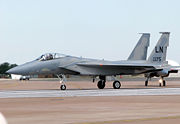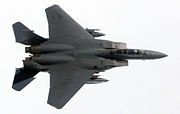F-15 Eagle
| F-15 Eagle | |
|---|---|
|
|
|
| USAF F-15 over Washington, D.C | |
| Role | Air superiority fighter |
| Manufacturer | McDonnell Douglas / Boeing IDS |
| First flight | July 27, 1972 |
| Introduction | January 9, 1976 |
| Status | Active |
| Primary users | United States Air Force Israeli Air Force Japan Air Self-Defense Force Royal Saudi Air Force |
| Unit cost | F-15A/B: US$27.9 million (1998) F-15C/D: US$29.9 million (1998)[1] |
| Variants | F-15E Strike Eagle F-15 S/MTD |
The McDonnell Douglas (now Boeing) F-15 Eagle is an all-weather tactical fighter designed to gain and maintain air superiority in aerial combat. It was developed for the United States Air Force, and first flew in July 1972. It is one of the most recognized fighters of the modern day. The F-15E Strike Eagle derivative is an all-weather strike fighter that entered service in 1989. The F-15 has not been shot down in air-air combat as of 2008. The U.S Air Force plans to keep the F-15 in service until 2025.[2]
Contents |
Development
Origins
During the mid-1960s U.S. Air Force intelligence was surprised[3] to find that the Soviet Union was building a large fighter aircraft, known as the MiG-25 'Foxbat'.[4] It was not known in the West at the time that the MiG-25 was designed as a high-speed interceptor, not an air superiority fighter;[5] as such, its primary asset was speed, not maneuverability. The MiG-25's huge tailplanes and vertical stabilizers (tail fins) hinted at a very maneuverable aircraft, which worried the Air Force that its performance might be higher than its American counterparts. In reality, the MiG's large fins and stabilators were necessary to prevent the aircraft from encountering inertia coupling in high-speed, high-altitude flight.
The F-4 Phantom II of the USAF and U.S. Navy was the only fighter with enough power, range and maneuverability to be given the primary task of dealing with the threat of Soviet fighters while flying with visual engagement rules.[4] As a matter of policy, the Phantoms could not engage targets without positive visual identification, so they could not engage targets at long ranges, as designed. Medium-range AIM-7 Sparrow missiles, and to a lesser degree even the AIM-9 Sidewinder, were often unreliable and ineffective at close ranges where it was found that guns were often the only effective weapon.[6]
The Phantom did not originally have a gun, as it was intended that only missiles would be used to engage slowly moving and maneuvering Warsaw Pact bombers and fighters at longer ranges. Experience in Vietnam showed this not to be the case and led to the addition of a gun. At first an external gun pod was tried but that proved inaccurate and increased drag. Later, the 20 mm M61 Vulcan was integrated internally on the F-4E.
F-X program

There was a clear need for a new fighter that overcame the close-range limitation of the Phantom while retaining long-range air superiority. After rejecting the U.S. Navy VFX program (which led to the F-14 Tomcat) as being unsuited to its needs, the U.S. Air Force issued its own requirements for the Fighter Experimental (F-X), a specification for a relatively lightweight air superiority fighter.[7] Four companies submitted proposals, with the Air Force eliminating General Dynamics and selecting Fairchild Republic, North American Rockwell, and McDonnell Douglas for the definition phase in December 1968. The companies submitted technical proposals by June 1969. The Air Force announced the selection of McDonnell Douglas on December 23, 1969.[8] The winning design resembled the twin-tailed F-14, but with fixed wings. It would not be significantly lighter or smaller than the F-4 that it would replace.
The Eagle's initial versions were designated F-15A for the single-seat configuration and F-15B (originally TF-15A, but this designation was quickly deprecated, as the F-15B is fully combat-capable) for the twin-seat. These versions would be powered by new Pratt & Whitney F100 engines to achieve a combat thrust-to-weight ratio in excess of 1 to 1. A proposed 25 mm Ford-Philco GAU-7 cannon with caseless ammunition was dropped in favor of the standard M61 Vulcan gun due to development problems. The F-15 retained conformal carriage of four Sparrow missiles like the Phantom. The fixed wing was put onto a flat, wide fuselage that also provided an effective lifting surface. Some questioned if the zoom performance of the F-15 with Sparrow missiles was enough to deal with the new threat of the high-flying MiG-25 "Foxbat", but its capability was eventually demonstrated in combat.

The first F-15A flight was made in July 1972 with the first flight of the two-seat F-15B (formerly TF-15A) following in July 1973.[9]
The F-15 has a "look-down/shoot-down" radar that can distinguish low-flying moving targets from ground clutter. The F-15 would use computer technology with new controls and displays to lower pilot workload and require only one pilot to save weight. Unlike the F-14 or F-4, the F-15 has only a single canopy frame with clear vision forward. The USAF introduced the F-15 as "the first dedicated USAF air superiority fighter since the F-86 Sabre."[10]

The F-15 would be favored by customers such as the Israel Air Force and Japan Air Self-Defense Force, and the development of the F-15E Strike Eagle would produce a strike fighter that would replace the F-111. However, criticism from the fighter mafia that the F-15 was too large to be a dedicated dogfighter, and too expensive to procure in large numbers to replace the F-4 and A-7, led to the Lightweight Fighter (LWF) program, which led to the USAF F-16 Fighting Falcon and the middle-weight Navy F/A-18 Hornet.
The single-seat F-15C and two-seat F-15D models entered production in 1978 with the models' first flights in February and June of that year.[11] These new models have Production Eagle Package (PEP 2000) improvements, including 2,000 lb (900 kg) of additional internal fuel, provision for carrying exterior conformal fuel tanks and increased maximum takeoff weight of up to 68,000 lb (30,700 kg).[12]
Improvements
The F-15 Multistage Improvement Program (MSIP) was initiated in February 1983 with the first production MSIP F-15C produced in 1985. Improvements included an upgraded central computer; a Programmable Armament Control Set, allowing for advanced versions of the AIM-7, AIM-9, and AIM-120A missiles; and an expanded Tactical Electronic Warfare System that provides improvements to the ALR-56C radar warning receiver and ALQ-135 countermeasure set. The final 43 included the enhanced-capability Hughes APG-70 radar, which was carried forward into the F-15E. The earlier MSIP F-15Cs with the APG-63 were later upgraded to the APG-63(V)1, which significantly improves reliability and maintainability while providing performance similar to the APG-70. The improvements were retrofitted to existing F-15s.[13]
Design

The F-15 has an all-metal semi-monocoque fuselage with a large cantilever shoulder-mounted wing. The empennage is all-metal twin fins and rudders with all-moving composite horizontal tail surfaces outboard of the fins. The F-15 has a spine-mounted air brake and retractable tricycle landing gear. It is powered by two Pratt & Whitney F100 axial-flow turbofan engines with afterburners mounted side-by-side in the fuselage. The cockpit is mounted high in the forward fuselage with a one-piece windscreen and large canopy to increase visibility.
The F-15's maneuverability is derived from low wing loading (weight to wing area ratio) with a high thrust-to-weight ratio enabling the aircraft to turn tightly without losing airspeed. The F-15 can climb to 30,000 feet (10,000 m) in around 60 seconds. The thrust output of the dual engines is greater than the aircraft's weight, thus giving it the ability to accelerate in a vertical climb. The weapons and flight control systems are designed so that one person can safely and effectively perform air-to-air combat.[7] The "A" and "C" models are single-seat variants that make up the bulk of F-15 production. "B" and "D" models add a second seat behind the pilot for training. "E" models use the second seat for a bombardier/navigator.
A multi-mission avionics system includes a head-up display (HUD), advanced radar, inertial guidance system (INS), flight instruments, ultra high frequency (UHF) communications, and Tactical Air Navigation (TACAN) and Instrument Landing System (ILS) receivers. It also has an internally mounted, tactical electronic-warfare system, "identification friend or foe" system, electronic countermeasures suite and a central digital computer.[14]

The heads-up display projects, through a combiner, all essential flight information gathered by the integrated avionics system. This display, visible in any light condition, provides the pilot information necessary to track and destroy an enemy aircraft without having to look down at cockpit instruments.[15]
The F-15's versatile APG-63/70 Pulse-Doppler radar system can look up at high-flying targets and down at low-flying targets without being confused by ground clutter. It can detect and track aircraft and small high-speed targets at distances beyond visual range (the maximum being 120 nautical miles (220 km) away) down to close range, and at altitudes down to treetop level. The radar feeds target information into the central computer for effective weapons delivery. The capability of locking onto targets as far as 50 nautical miles (90 km) with an AIM-120 AMRAAM enables true beyond visual range (BVR) engagement of targets. For close-in dogfights, the radar automatically acquires enemy aircraft, and this information is projected on the head-up display. The F-15's electronic warfare system provides both threat warning and automatic countermeasures against selected threats.[16]

A variety of air-to-air weaponry can be carried by the F-15. An automated weapon system enables the pilot to perform aerial combat safely and effectively, using the head-up display and the avionics and weapons controls located on the engine throttles or control stick. When the pilot changes from one weapon system to another, visual guidance for the required weapon automatically appears on the head-up display.[17]
The Eagle can be armed with combinations of four different air-to-air weapons: AIM-7F/M Sparrow missiles or AIM-120 AMRAAM advanced medium range air-to-air missiles on its lower fuselage corners, AIM-9L/M Sidewinder or AIM-120 missiles on two pylons under the wings, and an internal M61A-1 20 mm Gatling gun in the right wing root.[18]
Low-drag conformal fuel tanks (CFTs) were developed for the F-15C and D models. They can be attached to the sides of the engine air intake trunks under each wing and are designed to the same load factors and airspeed limits as the basic aircraft.[18] However, they degrade performance by increasing drag and cannot be jettisoned in-flight (unlike conventional external tanks). Each conformal fuel tank can hold 750 U.S. gallons (2,840 L) of fuel.[19] These tanks increase range thus reducing the need for in-flight refueling. All external stations for munitions remain available with the tanks in use. Moreover, Sparrow or AMRAAM missiles can be attached to the corners of the conformal fuel tanks.[12] The 57 FIS based at Keflavik NAS, Iceland was the only C-model squadron to utilize CFT's on a regular basis due to its extended operations over the North Atlantic. With the closure of the 57 FIS the F-15E is the only U.S. variant to carry them on a routine basis. The American CFTs were also provided to Israel and Saudi Arabia but only Israel uses them (as needed) on their entire fleet.
The F-15E Strike Eagle is a two-seat, dual-role, totally integrated fighter for all-weather, air-to-air and deep interdiction missions. The rear cockpit is upgraded to include four multi-purpose CRT displays for aircraft systems and weapons management. The digital, triple-redundant Lear Siegler flight control system permits coupled automatic terrain following, enhanced by a ring-laser gyro inertial navigation system.[20]